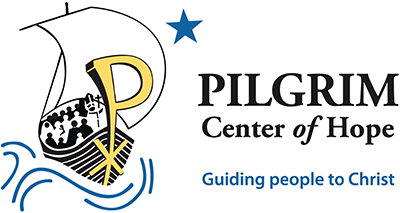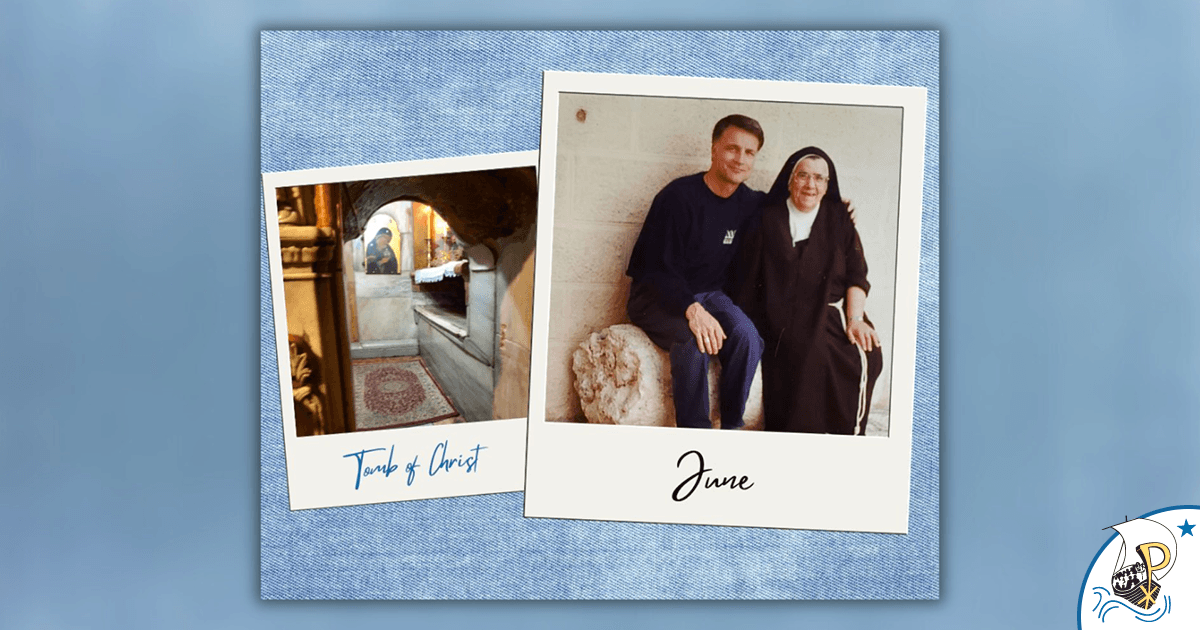This month we join Deacon Tom and Mary Jane Fox at the end their first visit to the Holy Land.
1984
Deacon Tom: The last place we visit in the Church of the Holy Sepulchre is the Tomb of our Lord. It is enclosed in an edifice adorned with hanging candles, carved marble, gold and silver. Upon entering, there is a chamber called the Chapel of the Rolling Stone or the Chapel of the Angels. In the middle of this very small chamber is a marble stand. Lifting the top, you see what remains of the stone that covered the Tomb. It is here the angels appeared to the women announcing, “He is not here, but has risen,” (Lk 24:6). From the small chamber you must crouch to enter an even tinier chamber. It is here where Jesus’ shrouded body was laid.
Mary Jane: Tom and I kneel to touch the marble slab over where our Lord, wrapped in the Shroud, was placed. I recall my miraculous healing when I was told to picture Jesus. What I saw was Jesus dressed in white standing at his tomb. He held one hand towards me and one hand towards the empty tomb. He looked at me and smiled, and now here we are, inside that very tomb. Here we are at the very spot Jesus resurrected to new life. Images from my past come to mind and I see that God has looked at me, has known me all my life. I think of the doctor’s words after discovering my incurable illness is gone, “Except for the scars, nothing remains.” I know Jesus healed me, giving me new life.
Deacon Tom: Before departing, we visit the Chapel of Adam located under the Cross. We look at the crack in the rock where tradition tells us Jesus’ blood flowed redeeming Adam who is thought to be buried here. We stand at the altar built over the site where the Resurrected Jesus first appears to Mary Magdalene. Here he looks at the woman he healed of seven demons and asks, “Woman, why are you weeping? Whom are you seeking?” (Jn 20:15). It is here that Jesus comforts her saying, “I am ascending to my Father and your Father, to my God and your God,” (Jn 20:17). It is from this very spot Mary Magdalene goes out spreading the great news, “I have seen the Lord!” (Jn 20:18).
Mary Jane: Tom and I are filled with hope. I know in my heart this is the beginning of something new in our lives. The more we talk, we discover we share this belief. Tom and I are sad to leave this special place and our new friends who have become family, but we are also excited. We want to return to our lives in America and share this experience, this beautiful gift from God. We desire, like St. Mary Magdalene, to tell the great news, “We have seen the Lord!”
Deacon Tom: Everything that is planted in the Holy Land grows. The land is so fertile that any plant introduced from anywhere else in the world not only grows, it thrives. The same can be said about a pilgrim who encounters Jesus Christ in the Holy Land. God used our time in the Holy Land to fertilize and water our tiny mustard seeds of faith that He had planted in our souls at Baptism. We returned home with greater faith and love for God and His Church and great hope for what was to come for Mary Jane and me.
Mary Jane: This growth included knowledge of the Universal Church which we witnessed through the variety of people we met in the Holy Land. We witnessed the intense love of God through the Catholic priests and nuns who minister to him by maintaining the holy sites and welcoming pilgrims. We were inspired to journey deeper in our faith through the pilgrims we met from all parts of the world. The most surprising discovery for Tom and me was to learn about and get to know the local Christians. These “living stones” as they are called, are descendants of the men and women who listened to Jesus preach, witnessed his miracles, followed him and were the first to believe in Jesus as the Son of God. One of the greatest gifts God has given us is the treasure of friendship with the people of the Holy Land.

The pilgrimage experience, journeys to places of faith always bring fruit. On their first visit to the Holy Land, the Foxes receive the fruit of Hope. In visiting where Jesus was born and lived, they discover God is real. They feel God’s love through his people in the Holy Land who they now call family. They encounter Jesus, the Source of Hope.
In proclaiming the Jubilee Year of Hope, Pope Francis wrote,
By his perennial presence in the life of the pilgrim Church, the Holy Spirit illumines all believers with the light of hope. He keeps that light burning, like an ever-burning lamp, to sustain and invigorate our lives. Christian hope does not deceive or disappoint because it is grounded in the certainty that nothing and no one may ever separate us from God’s love: “Who will separate us from the love of Christ? Hardship, or distress, or persecution, or famine, or nakedness, or peril or the sword? No, in all these things we are more than conquerors through him who loved us. For I am convinced that neither death, nor life, nor angels, nor rulers, nor things present, nor things to come, nor powers, nor height, nor depth, nor anything else in all creation, will be able to separate us from the love of God in Christ Jesus our Lord,” ( Rom 8:35.37-39). Here we see the reason why this hope perseveres in the midst of trials: founded on faith and nurtured by charity, it enables us to press forward in life. As Saint Augustine observes: “Whatever our state of life, we cannot live without these three dispositions of the soul, namely, to believe, to hope and to love.”

